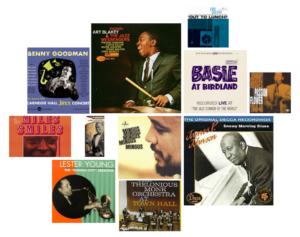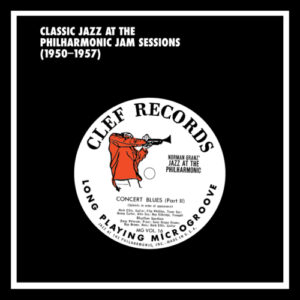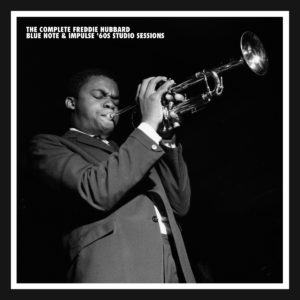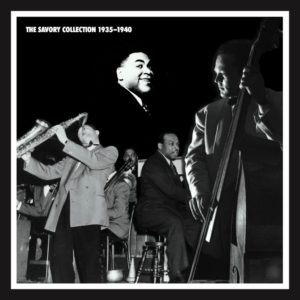
Best Jazz Albums:
1960s Modern Jazz
Page 1/2
The modern jazz of the 1960s was a crystallization of so many streams in the music. Hard bop reached its heights with composers like Wayne Shorter, Hank Mobley, Freddie Hubbard and Cedar Walton. The freedom principal was shaped by ensembles like the Ornette Coleman and Charles Mingus quartets. Miles Davis, John Coltrane and Randy Weston were among the pioneers who constantly evolved. What a period!
ART BLAKEY
MOANIN’
Art Blakey’s most successful album gave us Bobby Timmons’s “Moanin'” and Benny Golson’s “Along Came Betty” and “Blues March,” tunes so powerful that Blakey played them almost every night for the next 30 years. This beautifully performed and recorded session made the Jazz Messengers a jazz institution and put Golson, Timmons and Morgan to the forefront of jazz.
ART BLAKEY
MOSAIC
A magnificent album by the most explosive edition of the Jazz Messengers. The originals include Cedar Walton’s intricate title tune played with fire and brilliance, Wayne Shorter’s “Children Of The Night,” Curtis Fuller’s “Arabia” and Freddie Hubbard’s “Crisis” and “Down Under.” One of the most memorable records of an amazing era.
SONNY CLARK
LEAPIN’ AND LOPIN’
This 1961 session ranges from the modal “Melody In C” to the soulful blues “Somethin’ Special”. Ike Quebec guests on the magnificent ballad “Deep In A Dream”. Personnel: Sonny Clark (piano); Charlie Rouse (tenor saxophone); Tommy Turrentine (trumpet); Butch Warren (bass); Billy Higgins (drums).
JOHN COLTRANE
A LOVE SUPREME
Not only one of Coltrane’s most important recordings, but also one of the most significant modern jazz albums ever made. This four-part suite by the classic quartet exudes inner peace.
JOHN COLTRANE
CRESCENT
At once serene and exploratory, this exquisite masterpiece by the classic quartet is perfectly constructed and executed. Coltrane’s five compositions are varied and among the finest that he ever wrote. The music is rich in texture but in a rarified air as four master musicians listen intently to each other and create sublime interaction. Many consider this to be the greatest album by this band. Includes “Lonnie’s Lament” and “Bessie’s Blues.”
JOHN COLTRANE
COLTRANE
The first studio album after Jimmy Garrison joined the quartet with McCoy Tyner and Elvin Jones, this album, made over a series of sessions in April and June 1962, finds them pushing the envelope and exploring new territory. This new expanded edition includes the newly discovered June 20, 1962 sessions tapes which brings almost an hour of unissued Coltrane to light (CD 2, #1-8), including a studio version of “Impressions” in two exceptional takes and a new tune by McCoy Tyner “Not Yet”. This double CD has been remastered in 24 bit by the original engineer Rudy Van Gelder.
CHICK COREA
COMPLETE IS SESSIONS
In May 1969, at the height of his involvement with Miles Davis, Corea recorded these sessions, playing both acoustic and electric piano (often on the same track). From quartets by Bennie Maupin, Chick, Dave Holland and Jack DeJohnette to full-blown septet tracks with Woody Shaw, Hubert Laws and Horace Arnold added, the music covers cutting-edge contemporary tunes like “This” and “Song Of The Wind” and experimental free improvisations like “Is”. A unique chapter is the recorded history of the artist. Six alternates have been added to the eight tunes that made up the original albums “Is” and “Sundance”.
CHICK COREA
NOW HE SINGS, NOW HE SOBS
This adventurous yet lyrical trio LP was Chick Corea’s career breakthrough album, establishing him as a significant pianist and composer of modern jazz. Over three days in March 1968, Corea went into A & R Studios with Miroslav Vitous and Roy Haynes (they have since reunited many times over past 34 years) and produced a total of 13 great performances, only five of which were used on the original album. The material ranged from soon-to-be Corea classics like “Matrix” and “Windows” to extended improvised pieces like the title tune to creative interpretations of Monk’s “Pannonica” and “My One And Only Love”.
MILES DAVIS
E.S.P.
A breakthrough album for Miles Davis introducing new material and the fully-realized mid-sixties quintet with Wayne Shorter, Herbie Hancock, Ron Carter and Tony Williams. Includes “Eighty-One” and “Agitation”.
MILES DAVIS
MILES SMILES
One of the best jazz albums of all time by Davis’ mid-sixties quintet (Wayne Shorter, Herbie Hancock, Ron Carter and Tony Williams) with astonishing versions of “Gingerbread Boy”, “Freedom Jazz Dance” and Wayne Shorter’s “Dolores” and “Footprints”.
MILES DAVIS
NEFERTITI
The fourth album by the mid-sixties quintet includes the hypnotic title tune and introduces classics like “Riot” and “Pinocchio”.
BOOKER ERVIN
THE FREEDOM BOOK
One of the best and most underrated albums of the 1960s modern jazz. Ervin’s impassioned Texas tenor explodes with beauty and invention, fueled by the power and chemistry of Jaki Byard, Richard Davis and Alan Dawson. Brilliant, volatile music.
BILL EVANS
SUNDAY AT THE VILLAGE VANGUARD
Evans’s brilliant trio with Scott LaFaro and Paul Motian, which lasted only 19 months and made only 4 albums (“Explorations” and “Portrait In Jazz” in the studio and “Sunday At The Village Vanguard” and “Waltz For Debby” live), was one of those rare examples of perfect chemistry. LaFaro died just 10 days after the June ’61, Village Vanguard sessions.
BILL EVANS
UNDERCURRENT
Duet albums were rare in 1962 and encounters of this quality are still rare. Bill Evans and Jim Hall challenge and complement each other brilliantly on a series of standards and jazz music originals.
GIL EVANS
OUT OF THE COOL
Recorded shortly after “Sketches Of Spain,” this is Gil’s first real masterpiece on his own, with breathtaking arrangements of Kurt Weill’s “Bilbao Song,” George Russell’s “Stratusphunk” and his own “La Nevada.”
DEXTER GORDON
GO
Dexter Gordon considered this his finest album and few would disagree. With the perfect rhythm section of Sonny Clark, Butch Warren and Billy Higgins, this tenor giant reinvents standards like “Three O’Clock In The Morning,” “Second Balcony Jump” and “Guess I’ll Hang My Tears Out To Dry” and introduces his most famous composition “Cheese Cake.”
HERBIE HANCOCK
MAIDEN VOYAGE
Every single tune on this album from the haunting “Maiden Voyage” to the gentle, swinging “Dolphin Dance” has found its way into the standard jazz repertoire. Herbie Hancock fashioned a modern jazz milestone with extraordinary compositions, interplay and solos. Completing the quintet are Freddie Hubbard, George Coleman, Ron Carter and Tony Williams.
JOE HENDERSON
OUR THING
This is the third exceptional collaboration by Joe Henderson and Kenny Dorham (after “Page One” and “Una Mas”) with the cutting edge rhythm section of Andrew Hill, Eddie Khan and Pete LaRoca. The tunes and the playing are superb throughout. Added to the original album is an alternate take of “Teeter Totter”.
FREDDIE HUBBARD
OPEN SESAME
Freddie Hubbard’s recording debut announced the arrival of an extraordinary trumpeter, both technically and artistically. This album teamed him with tenor saxophonist & composer Tina Brooks (they would reconvene a week later to record Brooks’ “True Blue”) and pianist McCoy Tyner a few months before he joined John Coltrane’s quintet. This is one of those stunning Blue Note records where the musicians mesh and the tunes, arrangements and solo get as close to perfection as one can. A modern best jazz album classic.
FREDDIE HUBBARD
HUB-TONES
Already the most formidable new trumpeter in jazz in 1962, Freddie Hubbard came into his own as a composer with this album with great originals that range from the complex, ferocious swinger “Hub-Tones” to his poignant “Lament For Booker,” written for the late Booker Little. James Spaulding, Herbie Hancock, Reggie Workman and Clifford Jarvis are all at their peak, bringing the brilliant music to life with artistry and feeling.
FREDDIE HUBBARD
READY FOR FREDDIE
For his fourth Blue Note album, this remarkable trumpeter assembled a sextet with Wayne Shorter and Bernard McKinney anchored by John Coltrane’s rhythm section (McCoy Tyner, Art Davis and Elvin Jones). The album introduced three Hubbard originals (“Arietus”, “Birdlike” and “Crisis”) all of which would become jazz music standards.
RHASSAN ROLAND KIRK
RIP, RIG & PANIC
“Rip, Rig And Panic,” beautifully recorded by Rudy Van Gelder, was Kirk’s finest album of the sixties, possibly of all time. The explosive, energetic and versatile rhythm section of Jaki Byard, Richard Davis and Elvin Jones keep up with the saxophonist’s extraordinary flights that hit New Orleans and Mars and everything in between.
YUSEFF LATEEF
LIVE AT PEP’S
Considered one of Lateef’s greatest recordings, this electrifying 1964 quintet session with Richard Williams on trumpet, Mike Nock on piano, Ernie Farrow on bass and New Orleans legend James Black on drums runs the gamut from earthy to exotic with exceptional modern playing and writing.
ABBEY LINCOLN
STRAIGHT AHEAD
This 1961 session, which boasts Coleman Hawkins, Eric Dolphy, Booker Little, Mal Waldron and Max Roach among the supporting cast, is probably her greatest album. Composers Randy Weston, Mal Waldron, Thelonious Monk, Oscar Brown Jr. and lyricists Billie Holiday, Langston Hughes, Paul Lawrence Dunbar and Abbey Lincoln provide seven perfect vehicles for this album.

















